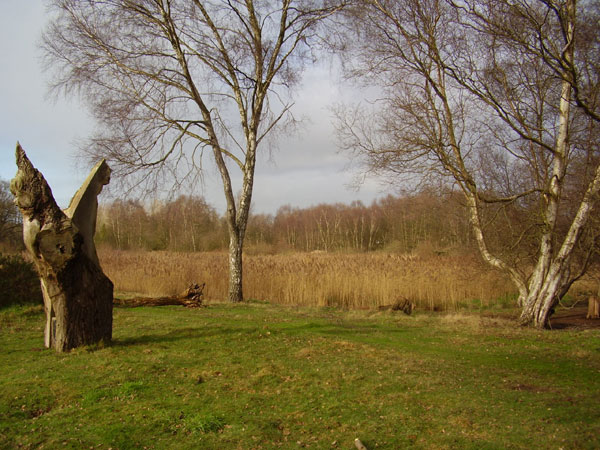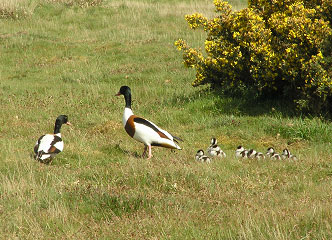Hinderclay Fen

View of Hinderclay Fen
Background
Hinderclay Fen forms part of the northern boundary of the parish of Hinderclay, alongside the Little Ouse River. It comprises areas of wet fen (sedges, reeds and other wetland plants), scrub, woodland, acid grassland and small patches of heathland, on generally poor soils.
Valley fens, such as Hinderclay Fen, were too waterlogged and the soils too poor to cultivate but were once an essential source of basic materials for the poorer people of the parish. Traditionally, commoners cut peat for fuel, fen hay for animal fodder and bedding, and grazed livestock.
In the absence of these requirements, and as a result of the deepening and straightening of the river to improve drainage from adjoining agricultural land, sites like Hinderclay Fen gradually dried out and many of the rare and beautiful species that lived there were lost. Hinderclay Fen was formerly designated as a Site of Special Scientific Interest (SSSI) but it deteriorated so severely that this designation was removed in 1983. Species that were lost during the second half of the 20th Century include rareties such as Grass of Parnassus (Parnassia palustris), Marsh Helleborine (Epipactis palustris), Bog Bean (Menyanthes palustris) and Fen Orchid (Liparis looseli).
Conservation

An area cleared of birch scrub

Recently cut sedge

The fen margin

Creating shallow ponds, 2005

A new turf pond, 2008

A Kingfisher
Management designed to benefit the wildlife of the fen, and especially some of the remaining characteristic and rarer fenland plants, was re-introduced in 2000. The LOHP aims to maintain the existing habitats within the Fen and to restore some of the wetland habitats that had been lost.
In 2001 and 2002 much of the wet fen vegetation was cut and removed to encourage new growth and prevent the accumulation of dead plant material: this raises the ground level and increases the likelihood of the wet fen drying out and being invaded by scrub. The open fen vegatation is now cut on rotation, with about a third of the area cut each year.
The wet fen has been extended by removing scrub that had invaded during the last forty years. The cleared areas have responded well, with a good variety of typical fen species recolonising. High water levels following prolonged heavy rain reveal a network of raised paths across the fen. These would have been used to access peat diggings.
In 2005, funding from the European Union allowed us to infill a series of very deep and sterile pools that been excavated on the Fen to provide some water in the very dry years in the early 1990s. The pools were filled first with birch wood, dervied from clearance of recent scrub that had invaded the open fen, and then with spoil from their original excavation. This had been dumped in a long, high ridge across the fen. Removal of this ridge is likely to restore more normal water movement across the fen to the river. The remaining pools are now shallow and more attractive to aquatic plants, amphibians, and invertebrates such as dragonflies.
LOHP volunteers continue dig new turf ponds in the wet fen to re-create the conditions needed for water-loving fen plants, amphibians and invertebrates. As the ponds become progressively shallower with time, and are colonised by new species, new ponds, with deeper water are needed to re-start the succession and create habitat for a wide range of fenland species. The increasing frequency of dry summers makes this programme of pond re-creation all the more important.
LOHP volunteers assess the success of management on our sites by monitoring changes in their wildlife. At Hinderclay Fen bird ringers run a BTO Constant Effort Site, catching and ringing birds during the summer months in a standardised way. In 2009, ringing on the Fen showed that at least 15 kingfishers were present! As well as telling us about changes in the breeding bird populations on the Fen, this information contributes to national trend information on abundance of adults and juveniles, numbers of young produced, and survival of adults for 25 species of common songbird.
Special Features

Adder's Tongue
Adder's-tongue (Ophioglossum vulgatum) is an unusual, small fern with a leaf-like blade and a long-stalked, fertile spike. It is typical of damp meadows and mown fens but has been lost from many lowland sites as a result of land drainage and agricultural intensification.

Ling on the sandy fen margin
Common Heather or 'Ling', (Calluna vulgaris), often growing with harebells (Campanula rotundifolia), heath bedstraw (Galium saxatile) and heath speedwell (Veronica officinalis), is a lovely feature of the drier sandy margins of Hinderclay Fen in late August and September.

Reindeer lichen
Reindeer lichens are so called because some of the larger species are an important fodder source for reindeer in northern Europe. Many of species are highly branched structures: their latin name 'Cladonia' is derived from the ancient Greek for a twig. All lichens are composed of an alga and a fungus living together and forming a stable and identifiable form. The Cladonia species are typical of poor, sandy soils but many have become rare because they are very suseptible to atmospheric pollution.

Water Rail
Water Rail: these secretive birds are usually heard and not seen. Their strange 'sharming' call, reminiscent of a pig being strangled, and deteriorating into grunts and squeals, is a familiar sound on all of the LOHP wetlands. In the UK they are amber listed because their population has declined in range by more than 25% over the last 25 years - probably as a result of loss of suitable wetland habitat.

Reed Warblers
Reed Warblers breed in the reedbed on the fen, returning here around the beginnning of May after overwintering in West Africa. Their chattering song, and the similar song of sedge warblers, is a feature of the fen in summer. They feed on insects and small spiders and rear up to two broods in cup-shaped nests, bound to the vertical reed stems.

Shelduck
Although mostly a coastal bird, Shelduck often attempt to breed in rabbit holes on the sandy heathland. This brood was reared successfully in 2009.
Access
The Angles Way Long Distance footpath runs along the entire length of Hinderclay Fen. There is also public footpath access from road to the south of the fen, opposite Holiday Farm. Please keep dogs under very close control to avoid disturbance to ground-nesting birds.


